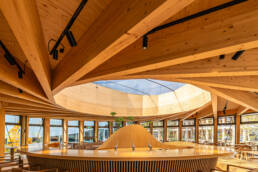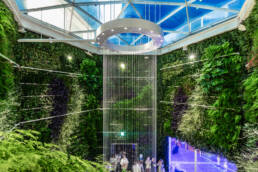Introduction:
Modern urban environments are a symphony of sensory experiences. The juxtaposition of towering structures, vibrant lights, and human presence creates a unique sensory landscape that shapes our perceptions and emotions. In this article, we delve into how urban environments influence our senses and explore the intricate relationship between cityscapes and human experience.
Sensory Overload in Urban Settings
Modern urban environments are inundated with stimuli, from the blinding lights of skyscrapers to the cacophony of traffic and street sounds. This sensory overload can significantly impact our mood, cognitive function, and overall well-being. Standing amidst these towering monoliths, individuals often experience a heightened sense of vulnerability and insignificance, yet also resilience and adaptation.
Architecture’s Role in Shaping Perception
Architecture plays a crucial role in shaping our sensory experience. The design, materials, and scale of buildings influence how we perceive our surroundings. Reflective surfaces on skyscrapers create a dynamic interplay of light and shadow, constantly altering our visual perception and affecting our psychological state. For instance, walking through a city at night, the reflections and artificial lights create an almost surreal environment, which can be both exhilarating and disorienting.
Human Presence Amidst Urban Giants
Human presence amidst these urban giants adds another layer to the sensory experience. The image of a pregnant woman against the backdrop of a towering skyscraper captures this contrast poignantly. It symbolizes the delicate balance between human vulnerability and the overwhelming scale of urban structures. This contrast highlights the constant negotiation between the natural and constructed worlds, a theme prevalent in modern city life.
The Influence of Urban Lighting
Lighting is another critical element that influences our sensory interaction with urban spaces. Streetlights, neon signs, and illuminated buildings guide our movement and evoke a range of emotions. The patterns created by these light sources can be mesmerizing, offering both aesthetic pleasure and practical guidance in navigating the cityscape.
Urban Spaces as Sensory Hubs
Urban spaces, such as parks and plazas, serve as sensory hubs where people gather, interact, and find respite from the relentless pace of city life. These areas offer a sensory reprieve, providing a contrast to the structured and often overwhelming urban environment. They foster social interactions and community bonding, essential for emotional and mental well-being.
Conclusion
Modern urban environments are a complex interplay of sensory stimuli that shape our daily experiences. By understanding how these elements influence our senses, we can design cities that enhance well-being and foster positive human interactions. The balance between the natural and constructed, the individual and the collective, is crucial in creating urban spaces that are not only functional but also enriching to human life.
Image Description
The featured image captures a pregnant woman silhouetted against a backdrop of a modern, illuminated skyscraper. The stark contrast between the human figure and the towering building emphasizes the theme of sensory overload in urban environments.
Related Posts
August 1, 2025
Behind the Lens: Documenting Germany’s Circular Pavilion at Expo 2025 Osaka
Go behind the scenes with Daisho Photography as we document Germany’s circular…
July 1, 2025
Behind the Scenes: Architectural Photography at Kansai International Airport
Discover how DAISHO Photography documented the newly completed areas of Kansai…
June 10, 2025
Behind the Lens: Photographing the Belgian Pavilion at Expo 2025 Osaka
Discover how we captured the lighting design of the Belgian Pavilion at Expo…




